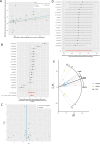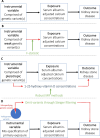Causal inference in health and disease: a review of the principles and applications of Mendelian randomization
- PMID: 39167758
- PMCID: PMC11523132
- DOI: 10.1093/jbmr/zjae136
Causal inference in health and disease: a review of the principles and applications of Mendelian randomization
Abstract
Mendelian randomization (MR) is a genetic epidemiological technique that uses genetic variation to infer causal relationships between modifiable exposures and outcome variables. Conventional observational epidemiological studies are subject to bias from a range of sources; MR analyses can offer an advantage in that they are less prone to bias as they use genetic variants inherited at conception as "instrumental variables", which are proxies of an exposure. However, as with all research tools, MR studies must be carefully designed to yield valuable insights into causal relationships between exposures and outcomes, and to avoid biased or misleading results that undermine the validity of the causal inferences drawn from the study. In this review, we outline Mendel's laws of inheritance, the assumptions and principles that underlie MR, MR study designs and methods, and how MR analyses can be applied and reported. Using the example of serum phosphate concentrations on liability to kidney stone disease we illustrate how MR estimates may be visualized and, finally, we contextualize MR in bone and mineral research including exemplifying how this technique could be employed to inform clinical studies and future guidelines concerning BMD and fracture risk. This review provides a framework to enhance understanding of how MR may be used to triangulate evidence and progress research in bone and mineral metabolism as we strive to infer causal effects in health and disease.
Keywords: epidemiology; genetic association studies; human association studies; mendelian randomization; therapeutics.
Plain language summary
Mendelian randomization is a powerful tool used by researchers to understand how factors like lifestyle choices or medical conditions affect our health. Some research studies can be hampered by inaccurate information or measurements which mean the results are unreliable. Mendelian randomization uses genetic information to evade this problem. Because a person’s genetic information does not change the studies can provide more reliable conclusions about how different factors influence our health. This review provides an overview of Mendelian randomization principles, its applications, and how researchers in bone and mineral research have used it to uncover cause-and-effect relationships.
© The Author(s) 2024. Published by Oxford University Press on behalf of the American Society for Bone and Mineral Research.
Conflict of interest statement
M.V.H. is an employee of 23andMe and holds stock in 23andMe.
Figures






References
Publication types
MeSH terms
Grants and funding
LinkOut - more resources
Full Text Sources

